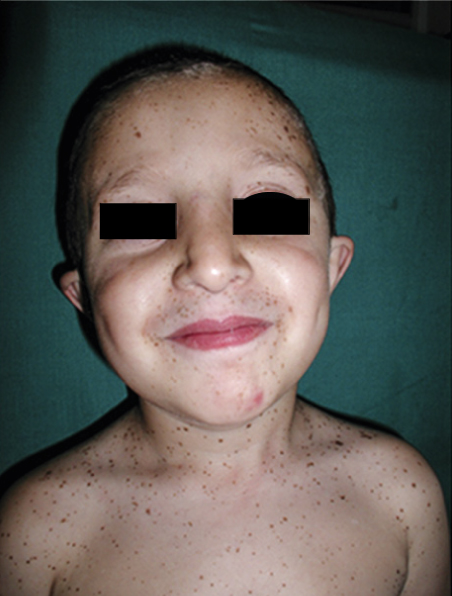LEOPARD syndrome
DOI:
https://doi.org/10.29176/2590843X.62Keywords:
Cardiomyopathy, hypertrophic, LEOPARD syndrome, skin diseases, geneticAbstract
The LEOPARD syndrome is a rare sporadic or autosomal dominant genodermatosis with high penetrance and variable expressivity.
The name LEOPARD is an acronym for its major features, which characterize the syndrome: multiple lentigines, electrocardiographic conduction defects, ocular hypertelorism, pulmonary stenosis, genitourinary abnormalities, retardation of growth and sensorineural deafness.
We present a case that illustrates some of the classic manifestations of the LEOPARD syndrome and highlight the importance of the studying, the monitoring and the multidisciplinary approach.
Author Biographies
María Angélica Macías, Hospital Simón Bolívar
Médica, dermatóloga pediatra, Hospital Simón Bolívar, Bogotá, D.C., Colombia
Ana María Téllez, Fundación Universitaria Sanitas
Médico dermatólogo, Fundación Universitaria Sanitas, Bogotá, D.C., Colombia
John Ballén, Fundación Universitaria Sanitas
Médico dermatólogo, Fundación Universitaria Sanitas, Bogotá, D.C., Colombia
Carolina Hernández, Universidad Militar Nueva Granada
Médica pediatra, Universidad Militar Nueva Granada, Bogotá, D.C., Colombia
References
Kalev I, Muru K, Teek R, Zordania R, Reimand T, Köbas K, et al. LEOPARD syndrome with recurrent PTPN11 mutation Y279C and different cutaneous manifestations: Two case reports and a review of the literature. Eur J Pediatr. 2010;169:469-73. https://doi.org/10.1007/s00431-009-1058-1
Martínez-Quintana E, Rodríguez-González F. LEOPARD syndrome: Clinical features and gene mutations. Mol Syndr. 2012;3:145-57. https://doi.org/10.1159/000342251
Carcavilla A, Santomé JL, Pinto I, Sánchez-Pozo J, Guillén-Navarro E, Martín-Frías M, et al. LEOPARD Syndrome: A variant of Noonan syndrome strongly associated with hypertrophic cardiomyopathy. Rev Esp Cardiol. 2013;66:350-6. https://doi.org/10.1016/j.recesp.2012.09.017
Tartaglia M, Gelb BD, Zenker M. Noonan syndrome and clinically related disorders. Best Pr Res Endocrinol Metab. 2011;25:161-79. https://doi.org/10.1016/j.beem.2010.09.002
Rodríguez-Bujaldón A, Vásquez-Brayo C, JiménezPuya R, Galán-Gutiérrez M. LEOPARD syndrome: What are café noir spots? Pediatr Dermatol. 2008;25:444-8. https://doi.org/10.1111/j.1525-1470.2008.00734.x
Kato H, Yoshida R, Tsukamoto K, Suga H, Eto H, Higashino T, et al. Familial cases of atypical clinical features genetically diagnosed as LEOPARD syndrome (multiple lentigines syndrome). Int J Dermatol. 2010;49:1146-51. https://doi.org/10.1111/j.1365-4632.2010.04559.x
Digilio M, Sarkozy A, de Zorzi A, Pacileo G, Limongelli G, Mingarelli R. Leopard syndrome: Clinical diagnosis in the first year of life. Am J Med Genet A. 2006;140:740-6. https://doi.org/10.1002/ajmg.a.31156
Treadwell P. Systemic conditions in children associated with pigmentary changes. Clini Dermatol. 2015;33:362-7. https://doi.org/10.1016/j.clindermatol.2014.12.014
Banuls J, Álvarez-Chinchilla PJ, Lucas A, Poveda I,Encabo-Durán B, Niveiro M, et al. Clinical, pathological and dermoscopic characteristics of cutaneous lesions in LEOPARD syndrome. J Eur Acad Dermatology Venereol. 2018;32:e100-1. https://doi.org/10.1111/jdv.14573
Koller VM, Giovanna PD, Otero M, García S, Cabrera H. Síndrome LEOPARD a propósito de la mancha café negro. Arch Agent Dermatol. 2009;59:53-7.
Jurko T, Jurko A, Krsiakova J, Jurko A, Minarik M, Mestanik M. Importance of cardiovascular examination in patients with multiple lentigines: Two cases of LEOPARD syndrome with hypertrophic cardiomyopathy. Acta Clin Belgica Int J Clin Lab Med.2018;3286:1-4. https://doi.org/10.1080/17843286.2018.1467531
Martínez-Quintana E, Rodríguez-González F. RASopathies: From Noonan to LEOPARD Syndrome. Rev Esp Cardiol. 2013;66:756-7. https://doi.org/10.1016/j.recesp.2013.05.006
González-Rodríguez A, Lorente-Gual R. Current indications and new applications of intense pulsed light. Actas Dermosifiliogr. 2015;106:350-64. https://doi.org/10.1016/j.ad.2014.10.004
Kontoes PP, Vlachos SP, Marayiannis KV. Intense pulsed light for the treatment of lentigines in LEOPARD syndrome. Br J Plast Surg. 2003;56:607-10. https://doi.org/10.1016/S0007-1226(03)00218-2
How to Cite
Downloads

Downloads
Published
How to Cite
Issue
Section
License

This work is licensed under a Creative Commons Attribution-NonCommercial-ShareAlike 4.0 International License.

| Article metrics | |
|---|---|
| Abstract views | |
| Galley vies | |
| PDF Views | |
| HTML views | |
| Other views | |






